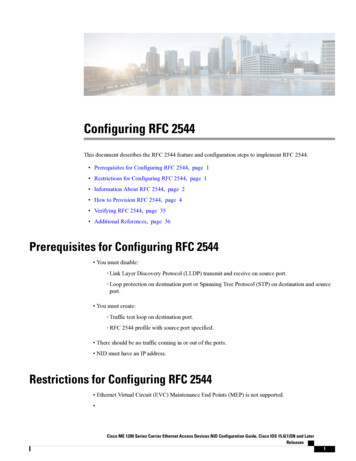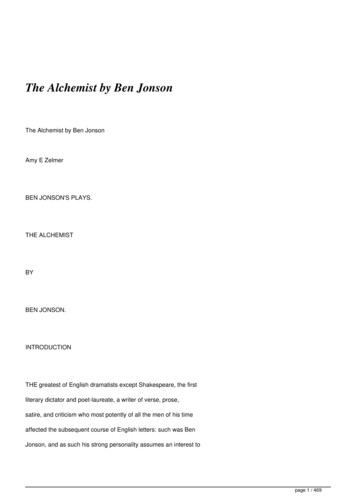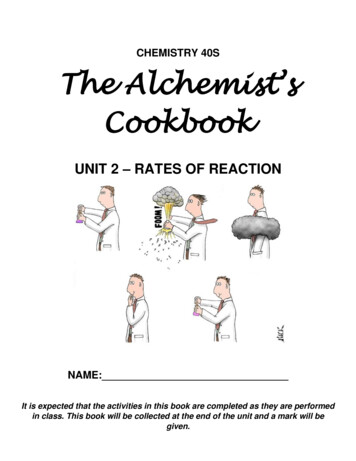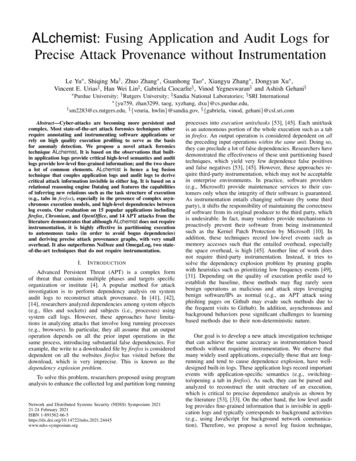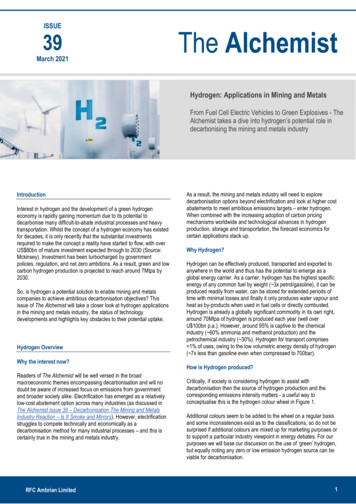
Transcription
ISSUE39March 2021The AlchemistHydrogen: Applications in Mining and MetalsFrom Fuel Cell Electric Vehicles to Green Explosives - TheAlchemist takes a dive into hydrogen’s potential role indecarbonising the mining and metals industryIntroductionInterest in hydrogen and the development of a green hydrogeneconomy is rapidly gaining momentum due to its potential todecarbonise many difficult-to-abate industrial processes and heavytransportation. Whilst the concept of a hydrogen economy has existedfor decades, it is only recently that the substantial investmentsrequired to make the concept a reality have started to flow, with overUS 80bn of mature investment expected through to 2030 (Source:Mckinsey). Investment has been turbocharged by governmentpolicies, regulation, and net zero ambitions. As a result, green and lowcarbon hydrogen production is projected to reach around 7Mtpa by2030.So, is hydrogen a potential solution to enable mining and metalscompanies to achieve ambitious decarbonisation objectives? Thisissue of The Alchemist will take a closer look at hydrogen applicationsin the mining and metals industry, the status of technologydevelopments and highlights key obstacles to their potential uptake.Hydrogen OverviewWhy the interest now?Readers of The Alchemist will be well versed in the broadmacroeconomic themes encompassing decarbonisation and will nodoubt be aware of increased focus on emissions from governmentand broader society alike. Electrification has emerged as a relativelylow-cost abatement option across many industries (as discussed inThe Alchemist Issue 38 – Decarbonisation The Mining and MetalsIndustry Reaction – Is It Smoke and Mirrors). However, electrificationstruggles to compete technically and economically as adecarbonisation method for many industrial processes – and this iscertainly true in the mining and metals industry.RFC Ambrian LimitedAs a result, the mining and metals industry will need to exploredecarbonisation options beyond electrification and look at higher costabatements to meet ambitious emissions targets – enter hydrogen.When combined with the increasing adoption of carbon pricingmechanisms worldwide and technological advances in hydrogenproduction, storage and transportation, the forecast economics forcertain applications stack up.Why Hydrogen?Hydrogen can be effectively produced, transported and exported toanywhere in the world and thus has the potential to emerge as aglobal energy carrier. As a carrier, hydrogen has the highest specificenergy of any common fuel by weight ( 3x petrol/gasoline), it can beproduced readily from water, can be stored for extended periods oftime with minimal losses and finally it only produces water vapour andheat as by-products when used in fuel cells or directly combusted.Hydrogen is already a globally significant commodity in its own right,around 70Mtpa of hydrogen is produced each year (well overU 100bn p.a.). However, around 95% is captive to the chemicalindustry ( 60% ammonia and methanol production) and thepetrochemical industry ( 30%). Hydrogen for transport comprises 1% of uses, owing to the low volumetric energy density of hydrogen( 7x less than gasoline even when compressed to 700bar).How is Hydrogen produced?Critically, if society is considering hydrogen to assist withdecarbonisation then the source of hydrogen production and thecorresponding emissions intensity matters - a useful way toconceptualise this is the hydrogen colour wheel in Figure 1.Additional colours seem to be added to the wheel on a regular basisand some inconsistencies exist as to the classifications, so do not besurprised if additional colours are mixed up for marketing purposes orto support a particular industry viewpoint in energy debates. For ourpurposes we will base our discussion on the use of ‘green’ hydrogen,but equally noting any zero or low emission hydrogen source can beviable for decarbonisation.1
ISSUEThe Alchemist39March 2021High rBlackGreyZero WhiteVariable netemissions(low / zero)Figure 1. Hydrogen ‘colours’ (middle ring), corresponding source(inner) and typical net emissions intensity (outer). Source: RFCAmbrianGreen – produced by the electrolysis of water powered by anyrenewable energy source.Brown/Black – the original hydrogen production source, produced bygasification of coal (in-situ or on-surface) creating a syngas which cancontain H2, CO, CO2, CH4 and various other gases. Brown vs. Black isused to further distinguish the rank of coal gasified.Grey - The most common source today, produced from steammethane reforming of natural gas, CH4 is split into hydrogen gas andCO2. For every 1t of H2 produced, around 10t of CO2 is emitted.Blue – Same as Grey hydrogen or Brown hydrogen, however the CO2is captured via a Carbon Capture and Storage (CCS) process.Turquoise – produced from methane pyrolysis; splitting the methanemolecule to produce hydrogen gas and solid carbon. Differs fromGrey hydrogen as no water/steam is used. Considered a low emissionhydrogen source as the carbon can be used for other applications.White – or natural hydrogen, produced from reservoirs in the earth’scrust, usually alongside helium and methane (rare at economicconcentrations). May also refer to hydrogen produced from in-situprocesses in hydrocarbon reservoirs such as in-situ gasification.Gold – gasification of biomass feedstock. Considered low emissionhydrogen (on a net basis), can be combined with CCS for zero netemissions.Yellow - produced by the electrolysis of water powered by theelectricity grid and therefore the emissions intensity associated with itsproduction is dependent on the local grid.Pink – produced by the electrolysis of water powered by nuclearenergy.RFC Ambrian LimitedGreen SteelSteel is generally produced via two methods; the Blast Furnace (BF)and Basic Oxygen Furnace (BOF) route or the Direct Reduced Iron(DRI) and Electric Arc Furnaces (EAF) route.BiomassBlueHydrogen Applications in Mining and MetalsBF’s rely on coking coal which provides heat and carbon thatindirectly reduces iron oxide ore. The carbon in coal reacts with theoxygen in iron ore to produce carbon metallic iron with carbon dioxideproduced as a by-product. The metallic iron is then placed in a BOF,oxygen and fluxes are added to lower the carbon content and producelow-carbon steel. Approximately 74% of steel globally is produced viaBOF.The use of hydrogen in BF’s involves the injection of hydrogen (orhydrogen rich gases) in the process to act as a reducing agent andalso provide a source of heat. Simulations indicate injection rates arelimited due to the cooling effect of H2 in the blast furnace, cappingemissions intensity reduction to around 15-20%. Thus, hydrogen canat best offer only a reduction in emissions for the BF-BOF pathway.The DRI pathway uses a reducing gas or elemental carbon to convertore to metallic iron without melting it. The reducing agents are carbonmonoxide and hydrogen, which can be provided from a number offeedstock materials such as natural gas (most common), coal orsyngas. As DRI occurs below the melting point of iron, it is consideredmore energy efficient when compared with BOF and is the keyfeedstock for EAF, being used to dilute scrap steel impurities. DRI andscrap steel is added to an electric arc furnace where high currentelectricity is used to produce liquid steel for casting. Current DRItechnology is also impacted by impurities in the iron ore feedstock(silica, alumina and phosphorus) and thus requires higher quality ironore feed.As hydrogen is a reducing agent for the DRI process the use of greenhydrogen to displace reformed (Grey) hydrogen is readily possible butrequires plant reconfigurations and significant on-site hydrogenproduction in addition to a source of carbon monoxide to make up thereductant gas. Consequently net zero emission green steel using theDRI-EAF pathway is theoretically possible.An established company developing green DRI is Midrex (US based).Midrex are building a 100% hydrogen based direct reductiondemonstration plant for ArcelorMittal in Hamburg which wasannounced in 2019. The plant will produce approximately 100ktpa ofDRI. The technology is an evolution of their natural gas DRI plants,with an intermediate phase allowing for extra hydrogen to be added tothe methane feedstock in concentrations up to 30%. The hydrogenundergoes pre-heating before entering the shaft furnace. Reductionoccurs around 900 C and temperature control is highly important.Hydrogen consumption is approximately 550-650 Nm3/t DRI ( 50-2
ISSUEThe Alchemist39March 202160kgH2/t DRI), with an additional 250 Nm3/t DRI of H2 or an equivalentheat source added to maintain the reaction.ThyssenKrupp has also announced the potential integration of DRIinto existing plants and will commission the first large scale plant in2024, utilising blue hydrogen supplied by Equinor.Europe’s steel industry is strongly embracing hydrogen, with the USalso demonstrating strong interest due to the large proportion of EAFmini-mills. In Australia, FMG, BlueScope and GFG’s Whyalla steelworks have also proposed potential green steel projects – howeverfirm plans are yet to be announced.Decarbonising steel production is a huge challenge, not just from acost perspective, but from an infrastructure view-point as well 100’s ofTWh of electricity production is needed to displace coal in theprocess. Regardless, this is a windmill worth tilting at, given steelproduction is responsible for 7% of global CO2 emissions (producing1t of steel produces 1.85tCO2e).Hydrogen based DRI-EAF seems likely to emerge as the onlyplausible low emission steelmaking process in the future. Hydrogen isalready used as a reducing agent in DRI, and although utilising greenhydrogen requires plant redesign, the approach overall is consideredfeasible. In fact, Midrex states their existing plants could be switchedto up to 90% hydrogen with only minor modifications. The currentchallenges for green hydrogen are broadly cost and scalability – it isestimated that a 2Mtpa H2 DRI plant would require a 900MWelectrolyser for hydrogen supply ( 144ktpa H2) and up to 8.8TWh ofelectricity, based on current technology (Source: Mckinsey). Toincentivise H2 DRI-EAF production it is estimated a carbon price of atleast US 65/t is required alongside a hydrogen price around US 2/kg.Figure 2. Midrex H2 Process. Source: MidrexAnother green DRI project is the HYBRIT project, a partnershipbetween LKAB, Europe’s largest iron ore producer, and Vattenfall toreplace existing BOF facilities in Sweden and Finland with EAF. Apilot plant has been launched in Lulea, Sweden to produce DRI at arate of 1tph using green hydrogen as the reducing agent andfossil-fuel free iron ore pellets. Following the pilot plant, ademonstration plant is slated for construction in 2023 and expected toproduce steel by 2026.Hydrogen is being explored for the BF-BOF pathway as well,ThyssenKrupp has outlined plans to produce 400kt of green steel by2025 increasing to 3Mt by 2030. To achieve these goals the companyhas announced plans for a 500MW electrolyser. The intention is toutilise hydrogen in the blast furnace and the company has completedthe first stage of trials, stating the process has a theoretic potential toreduce carbon emissions by up to 20%.Technology advances across the hydrogen supply chain shouldreduce the energy requirement, but there is still a very large amountof power required to electrify steel production. Also, an important note- a source of carbon is still required for the DRI-EAF process toprovide the carbon content for steel!Current Primary Steelmaking ProcessesFuel and FeedstocksElectricityCoalNatural GasHydrogenBiomassTotal Energy andEmissionsBF-BOFNatural Gas DRI-EAFEnergy(GJ/ton steel)0.718.01.0Emissions(kgCO2/ton steel)871,59250Energy(GJ/ton steel)2.50.510.1Emissions(kgCO2/ton steel)3124450819.71,73013.1864Low-CO2 Primary SteelmakingProcessesNatural Gas DRIH2 DRI-EAFEAF w/CCUS(HYBRIT)EnergyEnergy(GJ/ton steel)(GJ/ton steel)2.72.90.510.18.22.013.313.1Figure 3. Comparison of energy use for steel. Source: MckinseyRFC Ambrian Limited3
ISSUEThe Alchemist39March 2021Hydrogen Powered Mining FleetsHydrogen is increasingly stated as a promising zero-emissionalternative to diesel for heavy mining fleets, especially haul trucks anddiesel-powered freight trains. Such applications would fall under thecategory of Hydrogen Fuel Cell Electric Vehicles (FCEV) that converthydrogen to electricity via onboard fuel cells. FCEV fuel cells work bycombining hydrogen and oxygen to produce electricity and water, theelectricity is then used to power electric motors either directly, orindirectly via a battery – therefore their operation is similar to pureElectric Vehicles (EV’s) but use a smaller capacity battery. Onboardhigh pressure (350-700bar) hydrogen tanks feed the fuel cells andcan be refuelled at similar rates to Diesel (at pressure). Hydrogen canbe produced either on-site via electrolysis or transported to site.There are several aspects of FCEV’s which advantage their use in aheavy mining fleet over light vehicle-oriented EV, principally owing tohydrogen’s energy density;1)2)3)The batteries used in FCEVs are significantly smaller andtherefore lighter than an equivalent EV battery for a givencapacity – a rough estimate indicates for a hypothetical 200thaul truck ( 1,800kW / 2,400hp) to run continuously for 10hours at 50% load would require a battery weighing around45t (assuming a weight of 0.5t per 100kWh of battery). Thisadditional weight would directly reduce payload;As the primary fuel source is hydrogen, refuelling can occurrapidly – there is no need to recharge or swap batteriesenabling continuous operations; andThe power required to rapidly charge a battery of anymeaningful size is significant and a large mining fleet wouldquickly require hundreds of MWs of power, even whenconsidering staggered charging.Additionally, there are some positive aspects common with EV’s potential to integrate charging with a trolley system (say on the mainhaul road as First Quantum have done at the Kansanshi operation),less moving parts vs. diesel, fuel security, minimal impact fromaltitude and regenerative breaking. FCEV’s principal drawback is theround-trip efficiency of producing hydrogen, storing and converting toback to electricity (also known as well to wheel efficiency). Currentlythis is around half the efficiency of EV’s depending on the productionmethod/technology, although technology improvements across thehydrogen supply chain are expected to close the gap.The most advanced large scale hydrogen haul truck project is atAnglo American’s Mogalakwena mine. Anglo American has partneredwith Engie to convert a Komatsu 291t capacity 930E truck from dieselto a modular lithium-ion battery system with regenerative breaking,supplemented by a fuel cell module. The system is expected toproduce similar power and range to a 3,500hp ( 2.,600kW) dieselengine with the following major components:RFC Ambrian Limited 1,100 kWh battery system developed by Williams AdvancedEngineering8x 100kW PEM fuel cell modules (800kW total) provided byBallard Power SystemsHydrogen produced onsite via a 3.5MW electrolyser plantprovided by Nel Hydrogen and a refuelling system installedby Plug PowerDetails of the hydrogen storage capacity (and therefore the truck’srange) have not yet been disclosed. Anglo American has stated thehydrogen powered truck will replace 900,000 L of annual dieselconsumption, a 50-70% reduction in scope 1 and 2 emissions foropen pit mines, and cost parity with diesel is expected by 2030. Anglohas indicated a 40-truck rollout and 320MW of solar power producing1,000kgH2/day at Mogalakwena starting 2024.Figure 4: FCEV Haul truck. Source: Anglo AmericanOther FCEV mining specific projects also include: Fortescue Metals Group hydrogen fleet of 10 buses at theirChristmas Creek operations. The fleet is custom built byHYZON motors with hydrogen generated onsite using theChichester Solar Gas Hybrid Project. FMG also recentlyunveiled plans to consider hydrogen fuel cells to power a240t prototype haul truckWeichai’s 200t hydrogen demo fuel cell truck with 4x 85kWBallard fuel cells; trucks suitable for mine site testing areexpected to be produced sometime this year and use a total800kW of fuel cellsThe feasibility of FCEVs is edging forward with sectors of the marketmaturing; fuel cell powered forklifts in warehouses are already widelyadopted, FCEV buses are progressing towards commerciality and theworld’s first hydrogen trains have completed trials and are set toprovide regular service in Germany from 2022. Fuel Cells haveexperienced rapid growth in recent years - 908MW of Fuel Cells for4
ISSUEThe Alchemist39March 2021transport applications were shipped in 2019 (source: Fuel CellIndustry Review 2019). However, the ability to scale the technologyfor large trucks and mining fleets is still being validated.capture energy production which would otherwise be curtailed. Theeconomics of electrolyser utilisation will also need to be carefullyconsidered.Whilst trials for mining fleets have started, commercial application,comparable pricing to diesel and widespread adoption is still yearsaway. For reference, Komatsu plans to start their hydrogendevelopment program in 2021 and aims to have commercial units by2030, suggesting commercial scale up is approximately a decadeaway. However, increasing external pressure toward decarbonisationmay accelerate commercial application, particularly for new mines.Whilst there are an increasing number of mining projects utilisingbattery storage as a dispatchable power solution, hydrogen storagefor remote sites is limited. The leading example is the Raglan nickelmine operated by Glencore in Arctic Canada which commencedproduction late 2015 and comprises the following:Dispatchable Power SolutionsThe use of hydrogen for energy storage has significant potential forintegration into remote power girds, enabling such systems to achievehigher use of Variable Renewable Energy (“VRE”) without sacrificingavailability or reliability of power supply by supplying a sizeableenergy storage buffer. Excess electricity from VRE can be used toconvert water to hydrogen gas via electrolysis before it is compressedand stored. When power demand exceeds supply, a fuel cell is usedto produce electricity from the stored hydrogen, some electrolysertechnologies can also be reversed to double as a fuel cell.6MW wind turbine generator for VRE generation (3MW in2015 and 3MW added in 2018); 200kW/1.5kWh flywheel required to filter out short durationpower variations and aid with system inertia; 200kW/250kWh Li-Ion battery to start up diesel generatorsor fuel cells for transition backup; 200kW/1MWh power system (315 kW Electrolyser coupledto a 198 kW PEM fuel cell) to minimise loss of wind energyover longer time periods.The site is still dependent on diesel generation of 26MW for base loadgeneration and a further 9MW for peak load. Most existing remote power grids supplying mine sites (whethercaptive or not) are powered by generator sets, burning diesel, naturalgas or heavy fuel oil. Some sites have implemented hybrid systems integrating VRE and batteries into their power supply, however theseinstallation sites still require sizeable fossil fuel generation to balanceVRE. For example Gold Field’s Agnew gold mine has installed amicrogrid with 18MW wind, 4MW solar 13MW/4MWh battery storageand 21MW of gas powered engines – Agnew’s average load is around15MW. Despite 22MW of VRE coupled with battery storage,renewable generation provides on average 50-60% of total load, andcan experience material curtailment due to a mismatch between loadand generation during peak periods of VRE generation.The primary advantage of utilising hydrogen storage in a remotepower grid is the ability to achieve much higher renewable penetrationwhen compared to using batteries only. National Renewable EnergyLaboratory (NREL) has concluded batteries are better suited tointraday storage for up to 15 hours of power storage, whereashydrogen storage is suitable over a period of days, months and evenseasons and consequently an excellent complement to batteryinstallations. With adequate VRE, hydrogen storage can completelydisplace fossil fuel power generation, providing added fuel security.Hydrogen has the added benefit of mobility and can be transported tosite if required to shore up supply.Again, the primary disadvantage of hydrogen storage when comparedto batteries is the round-trip efficiency of conversion, which is currentlyin the order of 35%. For this reason, it is optimal to utilise a smallbattery to manage smaller changes in VRE generation first, and thenutilise hydrogen systems during periods of excess VRE production toRFC Ambrian LimitedFigure 5. Storage system at Raglan nickel mine, from left to right:hydrogen storage tanks, flywheel and substation, battery system, fuelcells and electrolyser. Source: Natural Resources CanadaThe above hybrid system, whilst relatively small in scale compared tothe total mine load still enabled a significant reduction in diesel use of4.4ML p.a. The storage component resulted in wind power availabilityof 97% and roughly doubled the wind penetration level whencompared to wind without the hybrid storage system (Source: Energyand Mines).Whilst the technology to produce and store hydrogen via electrolysis,and then use fuel cells to generate power has existed for decades,new technologies are needed to drive costs down, principally viaefficiency improvements. So, while existing commercial installations5
ISSUEThe Alchemist39March 2021indicate the technology could be implemented, widespread adoptionof integrated hydrogen storage is dependent on many technologieswhich are still in the development phase.Commercially, hydrogen use for remote power systems requiresadvancement in technologies across the hydrogen supply chain –electrolysers, storage and fuel cells – to drive down costs. Electrolyservolumes are growing rapidly for stationary power generation, howevergrowth is off a very low base - 221MW in 2019 (source: Fuel CellIndustry Review 2019). 100% renewable remote power grids withintegrated hydrogen storage are still some time away.2.Lower radiation heat transfer - potentially requiring addedmaterial for heat transport and new burners; and3. The potential to cause corrosion or brittleness in somemetals – requiring the use of different metal alloys and/orprotective coatings.As a result, a complete swap from natural gas to hydrogen will mostlikely require extensive modification to existing plant depending on theapplication.HeatingMany industrial processes require heat, in mining and metals commonapplications include kilns for drying ore, furnaces for steel production,boilers for steam production and Combined Heat and Power (“CHP”).Industrial sources of heat are predominantly provided by thecombustion of either coal, oil or natural gas and represent anestimated 42% of industrial emissions globally – equal to 23% ofglobal primary energy supply (Hydrogen Council 2017). Significantcontributors include the cement and aluminium industries. Hydrogenrepresents a relatively simple technological swap for fossil fuels as theheat output from combustion can replace heat supplied by fossil fuels,either as pure hydrogen or hydrogen blended with natural gas.Hydrogen can burn at a temperature up to 2,100 C which satisfiesmost industrial processes, it also has a high heat flux, good heatavailability and a high specific heat of combustion ( 2x natural gas).Hydrogen for residential heating is a relatively mature technology,particularly in Japan where government subsidies have assisted todrive over 300,000 residential fuel cells being installed from 2009 to2019. These systems use natural gas to produce and store hydrogenwhich is then used in the fuel cell, producing both electricity and heatand effectively creating a microgrid.Industrial heat applications utilising green hydrogen are less common,an example is Hyflexpower’s integrated pilot project to provide heatand power for a paper factory in France. The 12MWe CHP systemcurrently uses natural gas to power a gas turbine and recovery boiler– the steam is then used by the adjacent papermill. The project willinitially trial a hydrogen natural gas blend and ramp up to a hydrogenpercentage of at least 80%, with a target of 100%. Whilst applied inthe paper and pulp industry, an equivalent system could effectively beused to provide steam or heat for mineral and metals processing.The lack of hydrogen-to-heat projects is a function of technical andeconomic hurdles. Existing plants have been configured forcombustion of a specific fuel across several parameters. The IEAnotes several barriers for hydrogen substitution vs. natural gas,hydrogen has:1.Higher combustion velocity and nonluminous flame potentially requiring censors, controls, or added gases;RFC Ambrian LimitedFigure 6. Power-H2-Power Pilot. Source: SiemensDisplacing heat from fossil fuels is certainly a high-cost abatement BloombergNEF (BNEF) estimates that substituting zero-carbonhydrogen at a delivered price of US 1.00/kgH2 for aluminiumrecycling would be cost-effective with a carbon price of US 90/t CO2(2020). Similarly cement production would require a carbon price ofUS 60/t CO2. Given current green hydrogen prices generally range inestimates from US 5-10kgH2 the industry is a long way off, so weexpect progress in this area to be slow.As industries scale their carbon abatement curves, Hydrogen willlikely emerge as a promising candidate for decarbonising certainheating applications as other competing methods are predominatelylocation dependent or logistically constrained, such as geothermalheat, carbon capture and storage, solar thermal and heat frombiomass. Electric driven heating methods may also prove costeffective for low grade heat applications, such as heat pumps,electromagnetic heating (radio/micro/ultraviolet/infrared radiation,induction), electrical and resistance heating but struggle to supplyhigh grade heat economically.Blending Hydrogen with Natural GasThe concept of blending hydrogen into gas streams is not new – itsuse actually pre-dates natural gas distribution networks when coalwas burnt to produce ‘town gas’ which typically contained 30-50%hydrogen in the mid-1800’s. This method is a proposed means ofreducing emissions by displacing a portion of natural gas – currentestimates indicate 5-15% of hydrogen by volume is possible. Whilethis amount seems small, global natural gas demand was just under6
ISSUEThe Alchemist39March 20214,000Bcm in 2019 (source: IEA) (equivalent to 1,200TWh), sodisplacing even a small amount of natural gas use with greenhydrogen could have a large impact. Most existing appliances wouldnot require any modification at a low concentration, however gaspipelines would most likely require some upgrading in monitoring andintegrity at a minimum so some additional cost will need to beincurred.Hydrogen blending affords an opportunity for the mining and metalsindustry to reduce the emissions profile of their natural gas use. Forexample, natural gas supplied via pipeline with a portion of hydrogenwould reduce emissions from on-site electrical generation andheating. Blended gas streams can be combusted in both reciprocatingengines and gas turbines, offering a ‘drop-in’ emissions reduction.One such blend is known as Hythane – a 20% hydrogen, 80% naturalgas mix. At this ratio, minimal modifications are required to a naturalgas engine and studies indicate a greater than 20% reduction inemissions. The addition of hydrogen enables combustion of ultra-leanair/fuel mixtures, improving fuel economy and providing a small boostin torque due to an improvement in energy density compared withnatural gas alone.There are dozens of pilots and trials worldwide which havedemonstrated hydrogen blends up to 20% in natural gas networks andmany pilots have been undertaken in the US, Europe and Australia.So, while proven effective, a key issue is the long-term implications forthe natural gas network and end-use equipment. This is the key areaof research as hydrogen results in pipeline embrittlement andtherefore may cause premature failure, particularly at higherconcentrations. Another important consideration is the marginalbenefit of hydrogen blending vs. other applications, intuitivelyhydrogen has a greater environmental impact in displacing higheremitting fossil fuels such as coal and oil. For example, S&P PlattsAnalytics found that hydrogen blending with natural gas may have alower impact on emissions vs. other uses, in particular green steel.Regardless, it creates another use case for hydrogen to assist withadoption and represents a genuine way for mining and metalcompanies to reduce their emissions.Green ExplosivesJust as airlines market carbon offsetting for flights, explosivesmanufacturers could market ‘green explosives’ which miningcompanies purchase to reduce their scope 3 emissions (being thosewhich occur up- and down-stream of the mine gate). Put differently,this will only reduce emissions in the production of explosives – andhas no impact on emissions from detonating said explosives(unfortunately those emissions are rather unavoidable).Ammonium nitrate is produced by reacting ammonia with nitric acidand forms the foundation of most bulk explosives, including ANFOand emulsion explosives. The ammonia feedstock is produced viasteam methane reforming of methane gas to produce hydrogen whichis then reacted with nitrogen to produce ammonia via the Bosch-RFC Ambrian LimitedHaber process. Consequently, green hydrogen production can directlysubstitute grey hydrogen produced via steam methane reforming –directly displacing emissions and giving rise to ‘green explosives’ –and a satisfying oxymoron in the process.Multiple green amm
The Alchemist Issue 38 – Decarbonisation The Mining and Metals Industry Reaction – Is It Smoke and Mirrors). However, electrification struggles to compete technically and economically as a decarbonisation method for many industrial processes – and
